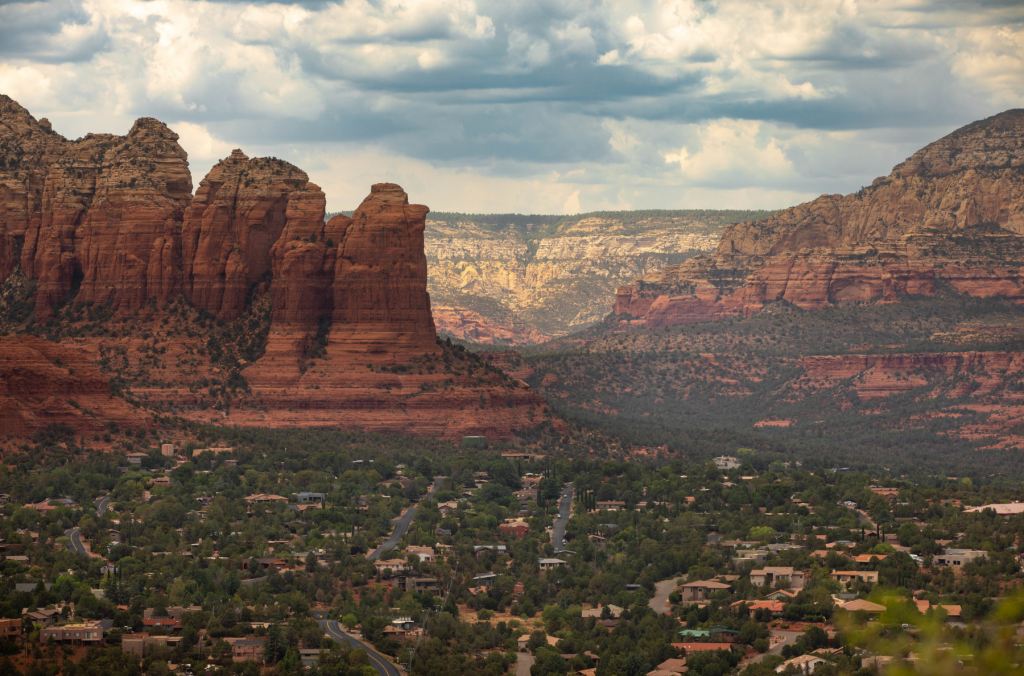
Superb Sedona!
Published on September 7, 2023
eATLAS has partnered with the Sedona Heritage Museum to create the Superb Sedona Adventure. The free, 60-minute tour features six stops where you can learn more about the town’s rich history, and even includes a stop at a local ice cream parlor! You can check it out here.
By Dave Lifton (@daveeatschicago)
People from all over the world are drawn to Sedona, Ariz., because of its extraordinary natural beauty, artistic community, and spiritual atmosphere. The city receives more than 300,000 visitors every year. That’s quite an accomplishment for a town of only 10,000 people 120 miles north of Phoenix and 110 miles south of the Grand Canyon.
Located 4,350 feet above sea level, Sedona is perhaps most famous for its colorful rock formations that have been evolving over 350 million years. The colors range from a pale pink to reddish-brown, and are the result of the oxidation of the iron deposits in the rocks.
Sedona’s known history can be traced back to roughly 11,000 B.C., but the earliest artifacts of settlements by indigenous people stem from around 4,000 years ago. Then, the Hohokam, Hakatya, and Sinagua tribes lived in the region. By approximately 1025 A.D., they had merged and learned how to plant beans, corn, squash, and agave in the desert climate. But an eruption at what is now Sunset Crater Volcano National Monument about 40 years later caused them to temporarily leave the area.
The Hopi and Navajo tribes arrived next and began to till the soil left by the volcanic ash. They were followed by the Anasazi, who merged with the Sinagua. Nearby cliff dwellings like Montezuma’s Castle and Tuzigoot were built during this period. But for reasons that remain a mystery, all the tribes had left the area by the middle of the 15th century and didn’t return for another 100 years.
Europeans arrived in 1583 in the form of a Spanish mining expedition. But it wasn’t until 1876 that John J. Thompson became the first permanent White settler when he built a ranch and farm in Oak Brook Canyon. In 1902, one of the new settlers, T.C. Schnebly, looked to establish a post office and named the spot after his wife, Sedona.

Millions of people have seen the scenery of Sedona without even knowing it. Starting with 1923’s The Call of the Canyon, the town has been used as a setting for almost 100 movies, including many Westerns starring some of the biggest names of the genre, like John Wayne, Henry Fonda, Randolph Scott, Gabby Hayes, and Glenn Ford. Among the most famous films are Angel and the Badman (1947), Broken Arrow (1950), Johnny Guitar (1954), and The Rounders (1965). Even Elvis Presley filmed one of his last movies, 1968’s Stay Away, Joe, in Sedona.
Sedona’s history as an artists’ haven began when a group led by Nassan Gobran, an Egyptian-born sculptor, purchased an apple packing barn in 1958 and transformed it into the Canyon Kiva as a collective for the town’s creative community. Three years later, the building was renamed the Sedona Arts Center, and has since been expanded to include a gallery, theater and classrooms. In 1965, the Cowboy Artists of America was formed to “authentically preserve and perpetuate the culture of Western life in fine art.” These days, Sedona is home to more than 80 galleries with works in nearly every medium, many of which hold special events on the first Friday of every month.
Sedona has also become a destination for those on healing, spiritual, and self-exploration retreats. The combination of red rocks and evergreen vegetation have led to numerous vortexes—spots where it is believed that positive energy flows— which have become popular locations for meditation, yoga, alternative healing, and other practices. The Sedona Tourism Bureau’s website has a comprehensive list of all the local spiritual and wellness businesses, as well as the many shops that sell crystals, books, and jewelry.
Found in Jordan Historical Park, the Sedona Heritage Museum is dedicated to preserving the city’s history through permanent exhibits about its early settlers, growth through the ranching and film industries, and Sedona Schnebly. Admission is $7.00 for adults and free for children under 13. An audio tour can be purchased for $10 (adults) and $2 (children).

The Adventure starts when you say it does.
All eATLAS Adventures are designed and built by experienced eATLAS Whoa!Guides. They're always on. Always entertaining. And always ready to go.
Check out our Adventures!